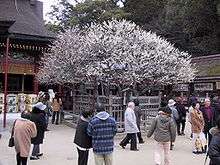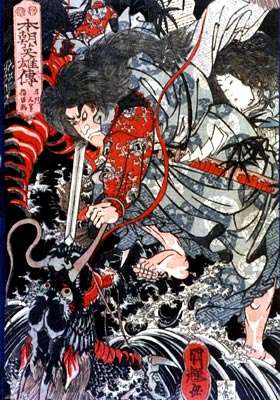Tenjin (kami)
| Look up Tenjin in Wiktionary, the free dictionary. |

In Japanese mythology and folklore, Tenjin (天神) is the Shinto kami of scholarship, the deification of a scholar, poet, and politician named Sugawara no Michizane. Ten 天 means sky and jin 神 means god or deity. The original meaning of Tenjin, sky deity, is almost the same as that of Raijin (a god of thunder).
Sugawara no Michizane
In Japanese history, Sugawara no Michizane rose high in the government of the country in the late 9th century, but at the beginning of the 10th century he fell victim to the plots of a rival, a member of the Fujiwara family, and was demoted and exiled to Kyushu. He died in exile in 903. Immediately afterwards, the capital city was struck by heavy rain and lightning, and many of the leading Fujiwara died, while fires caused by lightning and floods destroyed many of their residences.
The court of the emperor drew the conclusion that the disturbances were caused by Michizane's angry spirit, and, to placate it, the emperor restored all Michizane's offices, burned the official order of exile, and ordered that the poet be worshipped under the name Tenjin, which means sky deity. A shrine was established at Kitano; it was immediately raised to the first rank of official shrines, supported directly by the government.
Evolution into the patron of scholars
For the first few centuries, then, Tenjin was seen as a god of natural disasters, worshipped to placate him and avoid his curses. However, Michizane was a famous poet and scholar in his lifetime, one of the greatest of the Heian Period, and in the Edo Period scholars and educators came to regard him as a patron of scholarship. By the present day, this view has completely eclipsed natural disasters in popular worship.
Tenjin's influence is now regarded as particularly strong in passing exams, and so many school students, and their parents, pray for success at his shrine before important entrance exams, and return afterwards, if appropriate, to give thanks for success.
Things related to Tenjin

Michizane was very fond of ume trees, writing a famous poem from exile in which he lamented the absence of a particular tree he had loved in the capital. Legend states that it flew from Kyoto to Dazaifu in Kyushu to be with him, and the tree is still on show at his shrine there. As a result, shrines to Tenjin often are planted with many ume trees. By coincidence, these trees blossom in February, the same time of year as exam results are announced, and so it is common for Tenjin shrines to hold a festival around this time.
The animal particularly associated with Tenjin is the bull because, according to legend, during Michizane's funeral procession, the bull pulling the cart bearing his remains refused to go any further than a certain spot, which was then built up into his shrine.
Shrines
The main shrines to this kami are Kitano Tenman-gū in Kyoto and Dazaifu Tenman-gū in Fukuoka Prefecture, and the top three are rounded out by Egara Tenjin Shrine in Kamakura, but there are many other shrines dedicated to him across Japan. These shrines are called Tenman-gū (天満宮). A group of three notable shrines has been called the Three Great Tenjin Shrines.
See also
- Benedict of Nursia: patron of students and scholars.
References
- Shintō no Iroha (神道のいろは), Jinja Shinpōsha (神社新報社), 2004 (ISBN 4-915265-99-4).
- Mihasi, Ken (三橋健), Wa ga ya no Shūkyō: Shintō (わが家の宗教:神道), Daihōrin-Kaku (大法輪閣), 2003 (ISBN 4-8046-6018-6).

